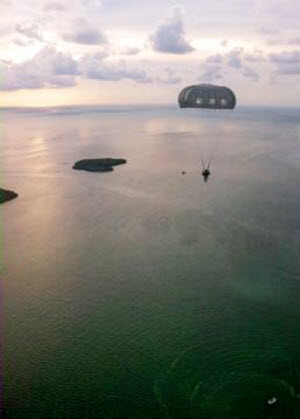Courtesy Story by: Maj. Robert Cowart, Special Operations Detachment - Africa, Texas Army National Guard
Posted: August 21, 2015
 Courtesy Photo
Courtesy Photo
A Texas Army National Guardsman with Special Operations Detachment - Africa, 71st Troop Command, jumps into the waters off of Key West, Fla., July 24, 2015. The jump, was part of a long-range, airborne water insertion and a culmination of three years of planning with active duty Army Special Forces, Air Force, Navy and U.S. Coast Guard to ensure that SOD-A always has trained and deployable personnel to conduct the many real world missions it is called upon to execute. (Courtesy photo by Special Operations Detachment - Africa)
KEY WEST, Fla. - As the ramp opened up, the smell of salty air and humidity filled the C-130. It was almost as thick as the enthusiasm displayed by the Texas Army National Guardsmen on board. The soldiers, part of the Special Operations Detachment – Africa (SOD-A), 71st Troop Command, conducted a long-range airborne insertion into the waters near Key West, Fla., July 24, 2015.
The exercise was a culmination of a three-year process, which executed the unit’s Mission Essential Task List training; a training plan designed to take units from an untrained status, to proficient and finally to a trained status – all leading to the unit’s ability to conduct its wartime mission.
“The key focus for this weekend is the Mission Essential Task, load out and deploy,” said Col. Doug O’Connell, SOD-A commander.
The SOD-A mission is to provide command and control for U.S. and coalition special operation forces within the U.S. Africa Command area of responsibility.
“Everything we have done, leading up to this weekend, are essential skills that we use on a regular basis, as we send small teams to remote locations,” said Lt. Col. Tim Ochsner, SOD-A executive officer.
Coordination for the operation involved several branches, which included reaching out to the Army’s Special Forces Underwater Operations School that helped secure the drop zone, lodging, watercraft and parachute drying facility; the Navy for the overall use of Naval Air Station Key West and for emergency management services during the airborne insertion operations; the Air Force helped with their C-130 aircraft for the trip to and from the insertion and the U.S. Coast Guard provided its galley for meals.
“After completing the water jump into Key West, the unit conducted recovery operations in preparation for redeployment back to Austin, said Maj. William “Rusty” Weedman, SOD-A logistical planner. “During the SOD-A's stay in Key West, they received support from the U.S. Coast Guard Sector Key West Galley and the Special Forces Underwater Operations School.”
With preparations set, the SOD-A members, assisted by 294th Quartermaster Company (Rigger), 36th Infantry Division, leapt from the aircraft, as members of the SFUOWS conducted drop zone operations, manned watercraft for recovery and provided medical coverage. Once all of the jumpers had successfully completed their required water sustainment jump, they transitioned to deploying-and-supporting dive team operations, in this case, the 5th Special Forces Group dive team as they conducted airborne water insertion and underwater infiltration operations.
Planning a training event with this many moving pieces is an enormous undertaking, but it ensures that SOD-A always has trained and deployable personnel to conduct the many real world missions it is called upon to execute, Ochsner said.
“Because the unit deploys small teams, almost quarterly to remote locations in Africa supporting missions and exercises, it is imperative that we find ways to conduct mission essential task list training while conducting steady state operations,” O’Connell said.